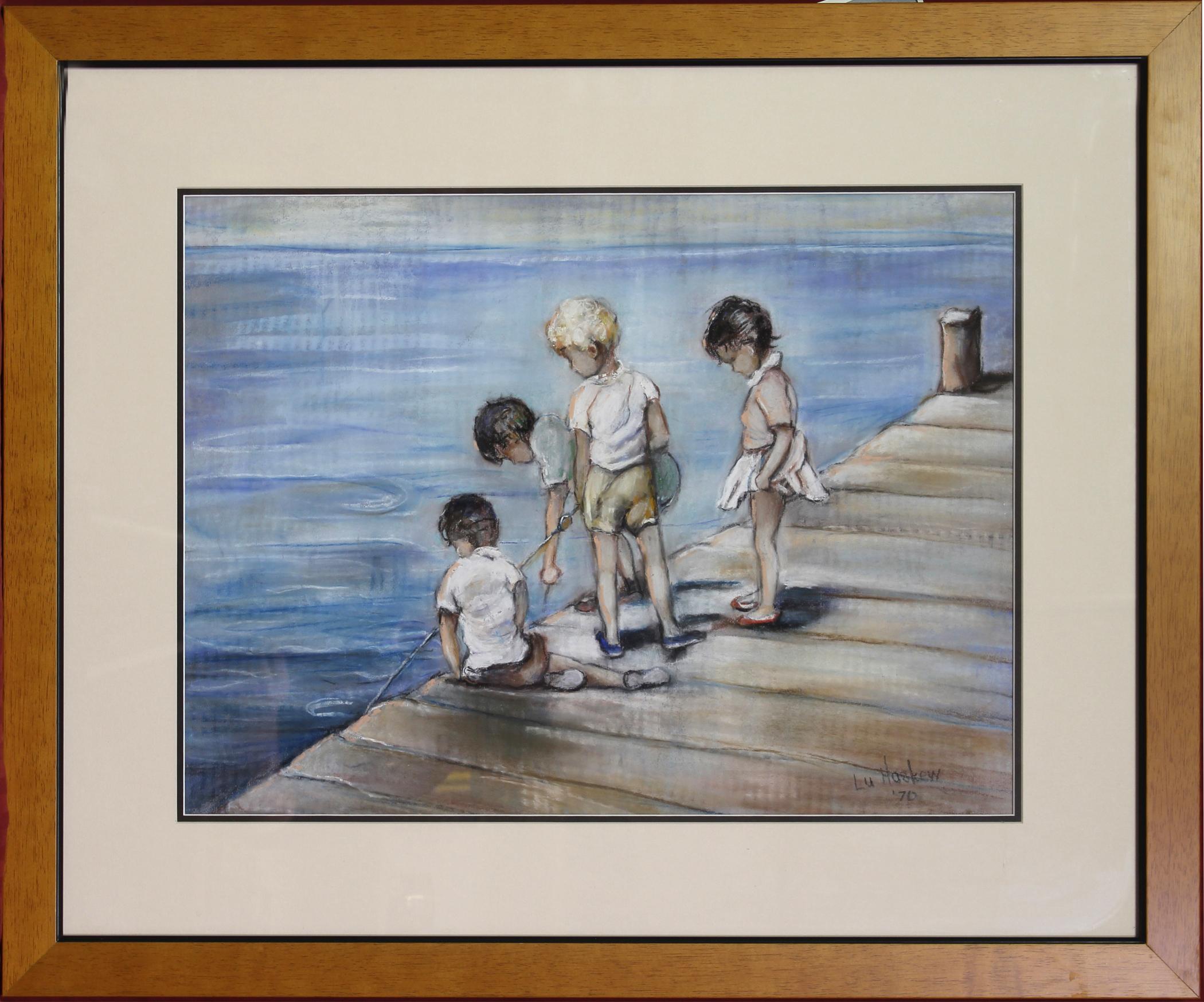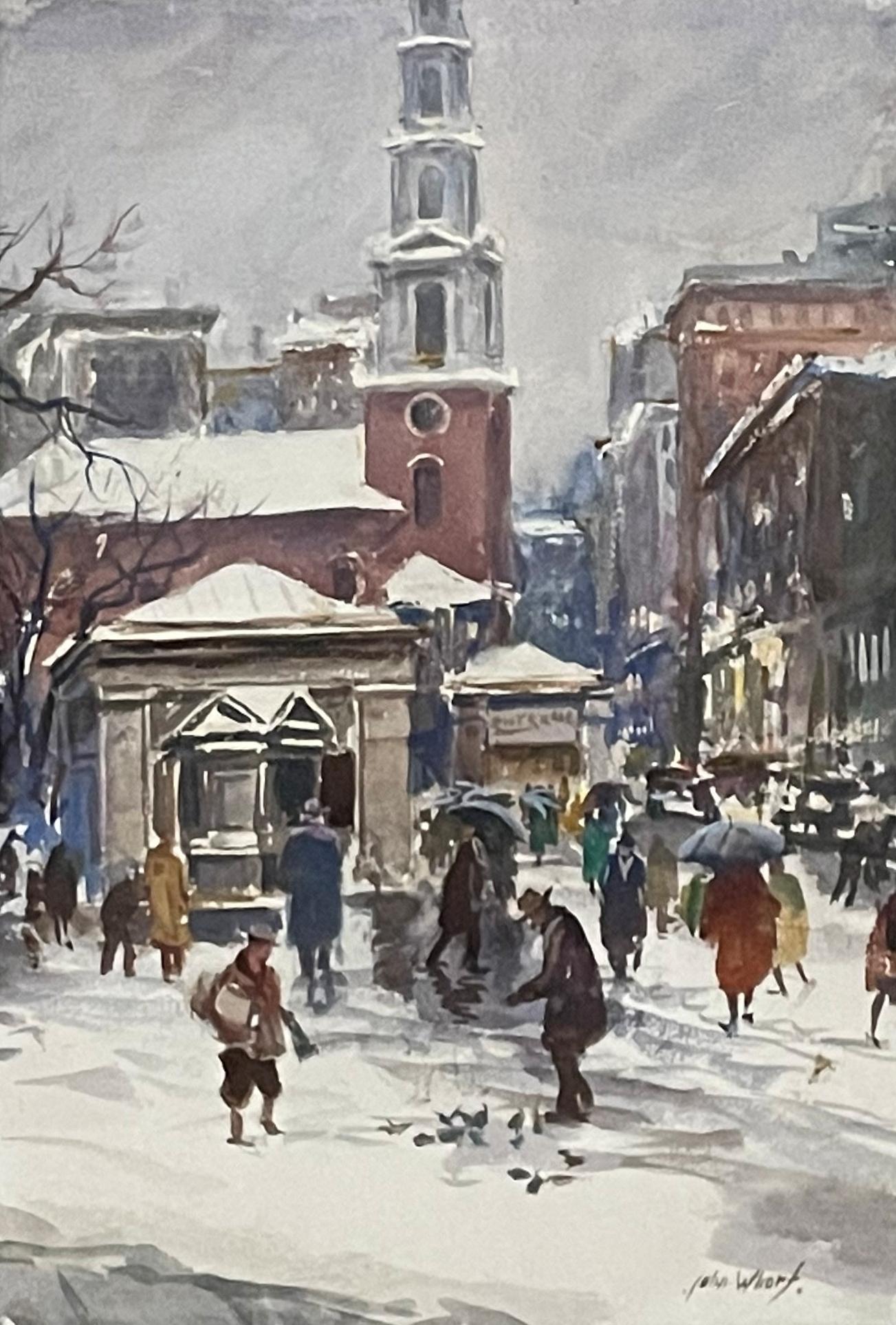Items Similar to Sangre de Cristo Mountains, Southern Colorado Watercolor Landscape Painting
Video Loading
Want more images or videos?
Request additional images or videos from the seller
1 of 16
Alfred WandsSangre de Cristo Mountains, Southern Colorado Watercolor Landscape Painting
About the Item
Vintage original modernist watercolor painting of the Sangre de Cristo Mountain range in Colorado by Alfred Wands (1904-1998). A farm in the foreground with mountains and sky in dominant shades of blue, green, white, yellow, violet and red. Presented in a custom frame, outer dimensions measure 28 ¼ x 34 x 1 ¼ inches. Image size is 16 ¼ x 23 inches.
Painting is clean and in very good vintage condition - please contact us for a complete condition report.
Expedited and international shipping is available - please contact us for a quote.
- Creator:Alfred Wands (1904 - 1998, American)
- Dimensions:Height: 28.25 in (71.76 cm)Width: 34 in (86.36 cm)Depth: 1.25 in (3.18 cm)
- Medium:
- Movement & Style:
- Period:
- Condition:very good vintage condition.
- Gallery Location:Denver, CO
- Reference Number:
Alfred Wands
Born in Cleveland, Ohio, Alfred Wands graduated from the Cleveland School of Art with honors. Following that, he spent six months in Paris studying at the Academie Julian. In the late 1920’s, Wands returned to Ohio to teach painting at the Cleveland School of Art and the Cleveland Museum of Art. In 1930, Wands moved to Denver to direct the art program at Colorado Women’s College. He remained at the Women’s College for the next 17 years. During his time in Denver, Wands frequently traveled to Taos, New Mexico. He and his family spent eleven summers there between 1930 and 1940. By 1943, he had become the Camp Artist at the YMCA of the Rockies, where he taught summer art classes. He later became the Chairman of their Religious Programs and Adult Advisory Committees. By 1947, he quit his teaching position at the Colorado Woman's College to devote full time to his painting. By 1955, Wands opened his own studio and gallery in Estes Park, Colorado. Known as the "Dean of Colorado Landscape Painters", he served three times as the President of the Denver Artists Guild. He was the Chairman of the Denver Art Commission for 16 years. Wands was a long-time member of the Denver Artists Guild and the Denver Art Commission. He was also a member of the Cleveland Society of Artists, Ohio Watercolor Society, and Chicago Galleries Association. Exhibited: Carnegie Institute., 1928; PAFA, 1924, 1926, 1928, 1932, 1934; PAFA Ann., 1926, 1929-30; WFNY, 1939; AIC, 1934, 1954; Corcoran Gal. biennial, 1935; CMA, 1923-37, 1939, 1940; Kansas City AI, 1930-34; Denver Art Museum, 1931-51, 1953, 1954; MFA Houston, 1950, 1951; Denver Museum of Natural History, 1953 (solo); San Francisco AA, 1950-52. Awards: prizes, Paris Salon, 1936; CMA, 1923, 1930; Chaloner prize, NYC, 1926; CPLH, 1932; Denver Art Museum, 1932, 1945-51; Kansas City AI (medal); 1934; Denver Art Guild, 1958 Works Held: BM; CMA; CPLH, 1932; Cleveland Public Schools; Denver Public Schools; Denver Art Museum: murals, Colorado Woman’s College; Methodist Church, Sterling, CO; Kansas City AI; Denver University Further Reading: Schlosser, Elizabeth. Modern Art in Denver: 1916-1960, Eleven Denver Artists. Ocean View Books: 1993.
Who Was Who in American Art 1564-1975: 400 Years of Artists in America, Vol. III. Peter Hastings Falk, Georgia Kuchen and Veronica Roessler, eds., Sound View Press, Madison, Connecticut, 1999. 3 Vols. ©David Cook Galleries, LLC
About the Seller
5.0
Platinum Seller
These expertly vetted sellers are 1stDibs' most experienced sellers and are rated highest by our customers.
Established in 1979
1stDibs seller since 2013
265 sales on 1stDibs
Typical response time: 3 hours
- ShippingRetrieving quote...Ships From: Denver, CO
- Return PolicyA return for this item may be initiated within 7 days of delivery.
More From This SellerView All
- Mountain Ranch, Modern Summer Colorado Mountain Landscape, Watercolor PaintingBy Irene D. FowlerLocated in Denver, COOriginal signed watercolor painting of a ranch in the Colorado mountains in springtime or summer coloring of green, blue, yellow, white and brown by Denver artist, Irene Fowler. Presented in a custom frame with all archival materials, outer dimensions measure 17 ½ x 23 ½ x 1 ½ inches. Image size is 12 x 18 inches. About the Artist: An important figure in the development of Denver as an artistic city, Irene Fowler was a public school teacher and founding member of the Denver Artist’s Guild (now the Colorado Artist’s Guild) in addition to being a prolific artist. She exhibited in Denver at the Schlier Gallery (where she had a solo exhibition), at the Chappell House, the University Club, and the Broadmoor Art Gallery in Colorado Springs. In 1950-1952 she served as president of the Denver Artist’s Guild. Fowler painted in oil or watercolor and her paintings were almost exclusively done en plein air. Her landscapes of Colorado...Category
Mid-20th Century American Impressionist Landscape Drawings and Watercolors
MaterialsWatercolor
- Colorado Ranch Summer Landscape Painting, 1940s Landscape WatercolorBy Irene D. FowlerLocated in Denver, COOriginal western landscape painting of trees near a ranch in Colorado by Irene Fowler, one of Colorado's preeminent women artists of the 20th century. Presented in a custom frame, outer dimensions measure 17 ½ x 23 ½ x 1 ½ inches. Image size is 11 ½ x 17 ¼ inches. Painting is clean and in very good vintage condition - please contact us for a detailed condition report. Expedited and international shipping is available - please contact us for a quote. About the Artist: An important figure in the development of Denver as an artistic city, Irene Fowler was a public school teacher and founding member of the Denver Artist’s Guild (now the Colorado Artist’s Guild) in addition to being a prolific artist. She exhibited in Denver at the Schlier Gallery (where she had a solo exhibition), at the Chappell House, the University Club...Category
Mid-20th Century American Impressionist Landscape Drawings and Watercolors
MaterialsWatercolor
- California Coast Landscape Marine Painting, Watercolor Painting Rocks, WavesBy Charles Partridge AdamsLocated in Denver, COCalifornia coastal painting by early 20th century artist, Charles Partridge Adams circa 1925. Watercolor on paper, not signed, attributed ...Category
1920s American Impressionist Landscape Paintings
MaterialsWatercolor
- Silver Plume, Colorado, Framed Colorado Mountain Landscape Oil Pastel DrawingBy Elsie Haddon HaynesLocated in Denver, COSilver Plume, Colorado - near Georgetown, mountain landscape with fall colors, Aspen and Pine trees, river, houses and mountains by early 20th century Co...Category
1930s American Impressionist Landscape Drawings and Watercolors
MaterialsOil Pastel, Pastel
- Mill Near Plainfield, New Hampshire, Landscape Painting, Charles Partridge AdamsBy Charles Partridge AdamsLocated in Denver, CO"Mill Near Plainfield, New Hampshire" is an original, signed watercolor painting by artist Charles Partridge Adams (1858-1942), circa 1900. Singed by the artist in the lower left corner. Portrays a mill along a river with trees and clouds, painted in shades of brown, green, gray, and blue. Presented in a custom frame, outer dimensions measure 13 ¾ x 12 ¼ x 1 ¼ inches. Image size is 7 x 5 inches. Expedited and international shipping is available - please contact us for a quote. About the Artist: Born Massachusetts, 1858 Died 1942 Born in Franklin, Massachusetts, Charles Partridge Adams moved with his mother and two sisters to Denver, Colorado, in 1876 in an effort to cure the two girls who suffered from tuberculosis. In Denver, Adams found work at the Chain and Hardy Bookstore. He received his first, and only, art training from the owner's wife, Helen Chain. Mrs. Chain, a former pupil of George Inness, provided instruction and encouragement to the young artist and introduced him to other artists in the area including Alexander Phimister Proctor...Category
20th Century American Modern Landscape Drawings and Watercolors
MaterialsWatercolor, Archival Paper
- 1930s Colorado Modernist Landscape Painting of Trees, Mountains & HousesLocated in Denver, COColorado Modernist landscape, watercolor on paper by Turner B. Messick (1878-1952) from 1938. Tree with houses and mountains in the background, pain...Category
1930s American Modern Landscape Paintings
MaterialsArchival Paper, Watercolor
You May Also Like
- Searching the WatersBy Lu HaskewLocated in Loveland, COSearching the Waters by Lu Haskew Pastel 18x22" image size, 26x30" framed Figurative Portrait of young children on a dock looking into the water. ABOUT THE ARTIST: Lu Haskew 1921...Category
1990s American Impressionist Landscape Paintings
MaterialsWatercolor
- Canyon CountryBy Lu HaskewLocated in Loveland, COCanyon Country by Lu Haskew Pastel 16x20" image size Landscape view of the Grand Canyon ABOUT THE ARTIST: Lu Haskew 1921-2009 "Life is good to me. Being able to go to my studio five days weekly and paint for several hours, living in a supportive community, having family and friends who encourage me--all have contributed to helping me become an artist. Being fortunate to study with some of the artists I admire has kept me painting from the garden, people and my favorite things. With the support of galleries, teaching and doing demos, how could I do anything else? My goal is to try to be the best I can be by always being a student, looking for new ideas and stretching my horizons." Upon retirement from a 33-year teaching career, Lu rented a studio in Loveland and began concentrating on her oil and watercolor painting. Learning from artists she had followed and admired throughout the years her painting became a full time career. Since 1992, she has studied with renowned painters Richard Schmid, Clyde Aspevig, Joyce Pike, and others at the Scottsdale Art...Category
1990s American Impressionist Landscape Paintings
MaterialsWatercolor
- "Park Street Church, Boston, " John Whorf Impressionist Watercolor WPA CityscapeBy John WhorfLocated in New York, NYJohn Whorf (1903 - 1959) Park Street Church, Boston, circa 1930-45 Watercolor on paper 21 x 15 inches Signed lower right Housed in its original frame Provenance: Milch Gallery, New ...Category
1930s American Impressionist Landscape Drawings and Watercolors
MaterialsWatercolor, Paper
- Mount MonadnockBy Frank Weston BensonLocated in Milford, NHAn exceptional watercolor of Mount Monadnock snow capped in winter in New Hampshire by American artist Frank Weston Benson (1862-1951). Benson was born in Salem, Massachusetts and went on to study in Boston at the Museum School of Fine Arts and later with Julian Lefebvre and Gustave Boulanger at the Academie Julian in Paris. Benson was well known for his impressionist landscapes and seascapes, and etchings of hunting scenes. Watercolor on paper, signed lower left F.W. Benson with inscription “To Mrs Bush,” titled on Vose Galleries...Category
Early 20th Century American Impressionist Landscape Drawings and Waterco...
MaterialsWatercolor, Paper
- Mount MonadnockBy Gifford BealLocated in Milford, NHA fine monochromatic watercolor landscape painting of Mount Monadnock in New Hampshire by American artist Gifford Beal (1879-1956). Beal was born in New York City and studied for man...Category
Mid-20th Century American Impressionist Landscape Drawings and Watercolors
MaterialsPaper, Watercolor
- "River Landscape" Julian Alden Weir, American Impressionist, Connecticut SceneBy Julian Alden WeirLocated in New York, NYJulian Alden Weir River Landscape Signed lower left Watercolor on paper 9 x 11 1/2 inches Provenance: Kraushaar Galleries, New York Sotheby's Parke Bernet, New York, 1965, Lot 27 E....Category
Late 19th Century American Impressionist Landscape Drawings and Watercolors
MaterialsWatercolor, Paper
Recently Viewed
View AllMore Ways To Browse
Southern Landscape
Southern Landscape Art
Vintage Mountain Art
American 20th Century Colorado
Vintage Mountain Landscape
Southern Colorado
Vintage Colorado
Watercolor Landscapes Colorado
Modernist Colorado
Vintage Mountain Painting
Colorado Modernist
Mountain Farm
Farm Painting Mountains
Vintage Green Farms
Vintage Wand
Vintage Farm Paintings
Sangre De Cristo
Sangre De Cristo Mountains


